Think you’ve seen it all? Then you’d better get familiar with ‘Chicho’, Kenny Harrison’s crazy Camaro low-rider
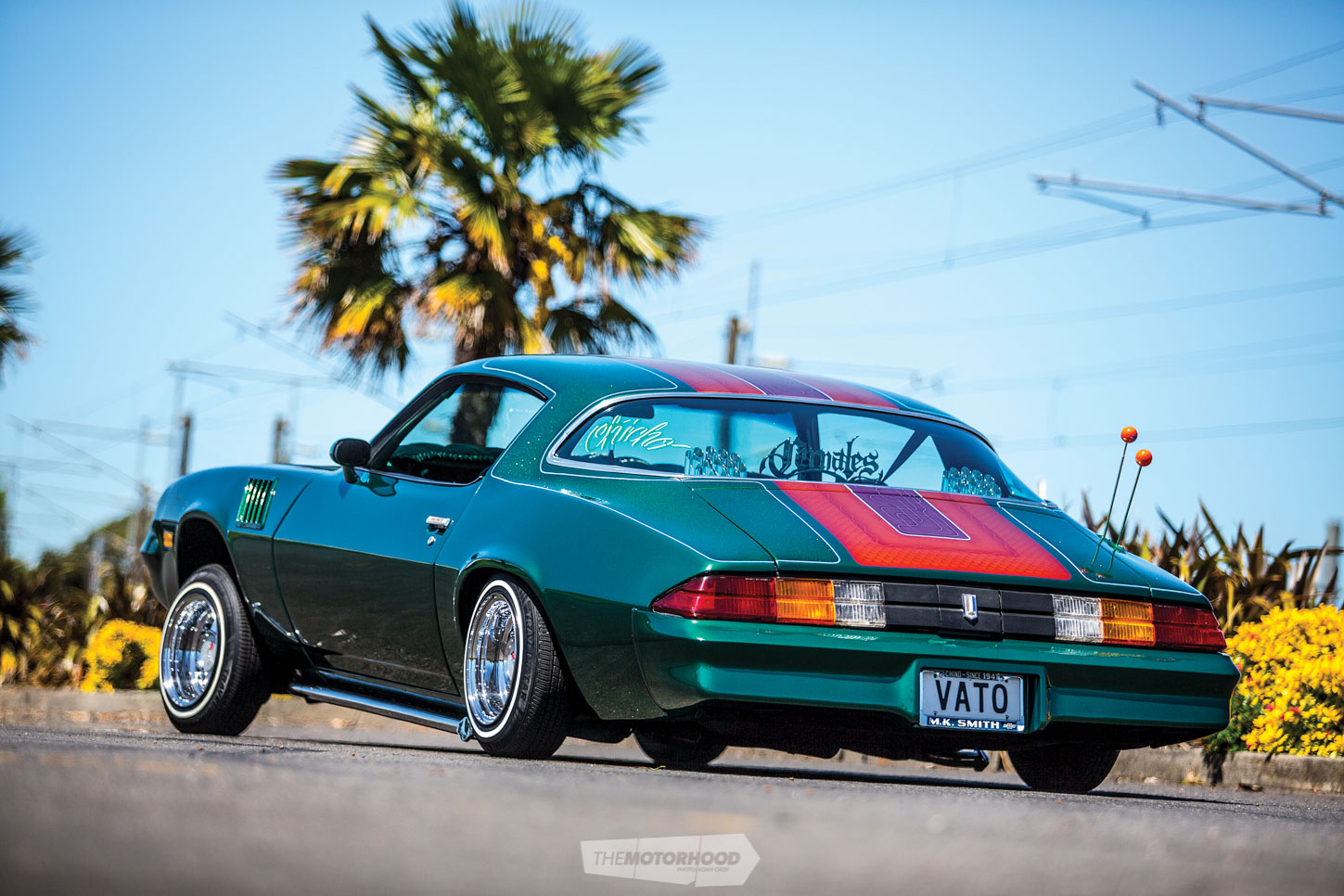
“I knew this car was going to turn heads, and people were going to either love it or hate it,” says Kenny Harrison of his low-riding second-gen Camaro, affectionately known as ‘Chicho’. When it comes to low-riding, you either get it or you don’t — if you don’t, then you’re probably looking at Kenny’s car as though it has come from another dimension; if you do — well, this Camaro is the perfect representative of the art that is low-riding: cruising in style, low and slow.
“I was brought up in and around American cars,” Kenny recalls, “and I couldn’t wait to get my own.”
Kenny’s first American car was a ’46 Chev Fleetmaster, acquired more than 12 years ago — the perfect vehicle in which to cruise with a bunch of good mates on warm summer days. He owns it to this day, but it wasn’t long before he wanted another project — something a little different.
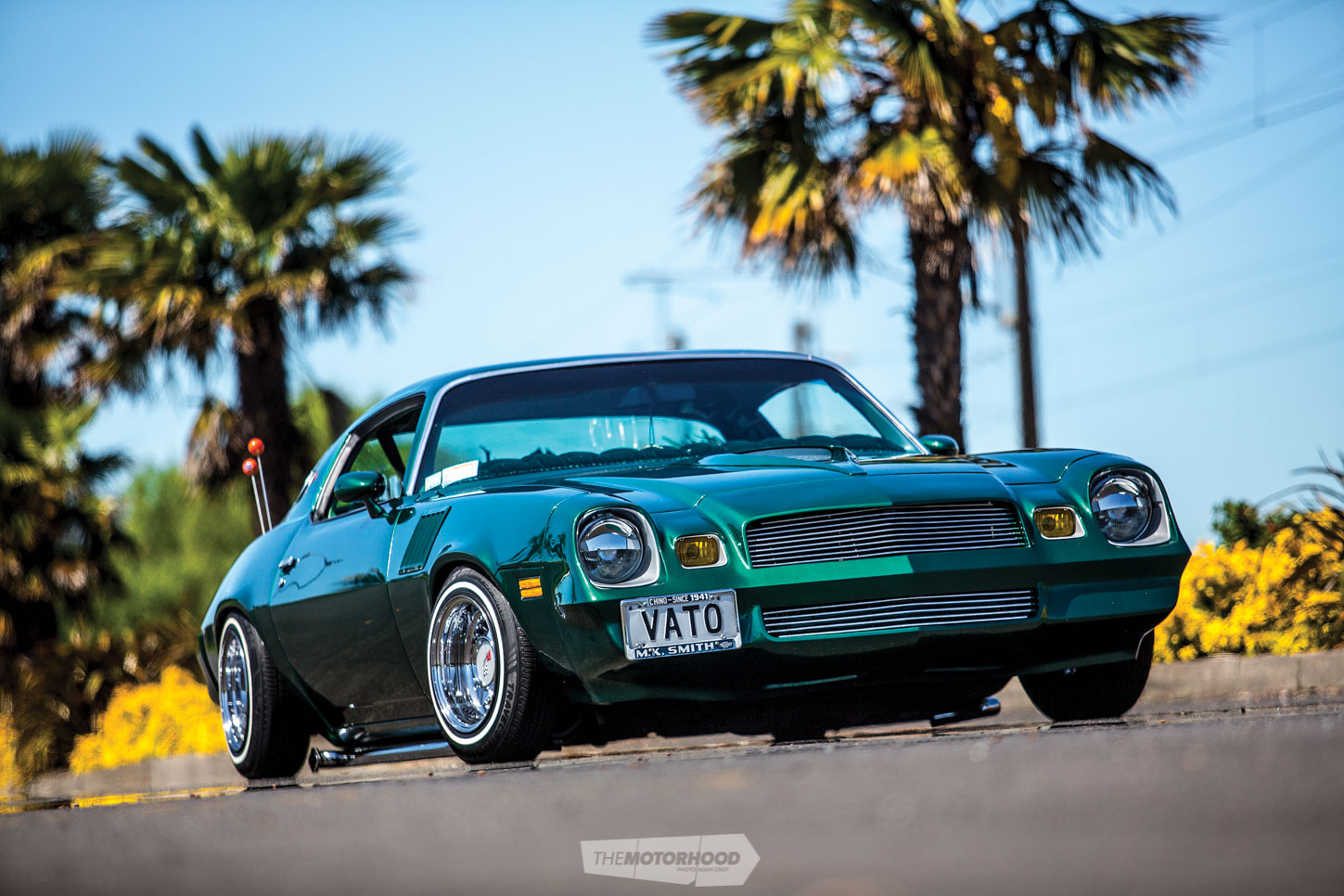
“I wanted to build an old-school late-’70s or early-’80s low-rider. It wasn’t uncommon to see second-generation Camaros cruising the streets in full low-rider attire back then, and I liked the design of the Camaros, with their long, low, sleek lines,” Kenny says. “They look even better when laid out.”
That’s how New Zealand’s most different Camaro came to fruition. “I set about looking for a Camaro in New Zealand, and it had to be driving and on the road,” Kenny tells us.
The Camaro that made the cut was found on Trade Me listed for a reasonable asking price. With his brother Chris in tow, Kenny made the trip down to check it out, and, after taking a weekend to think it over, concluded that this Camaro was the one.
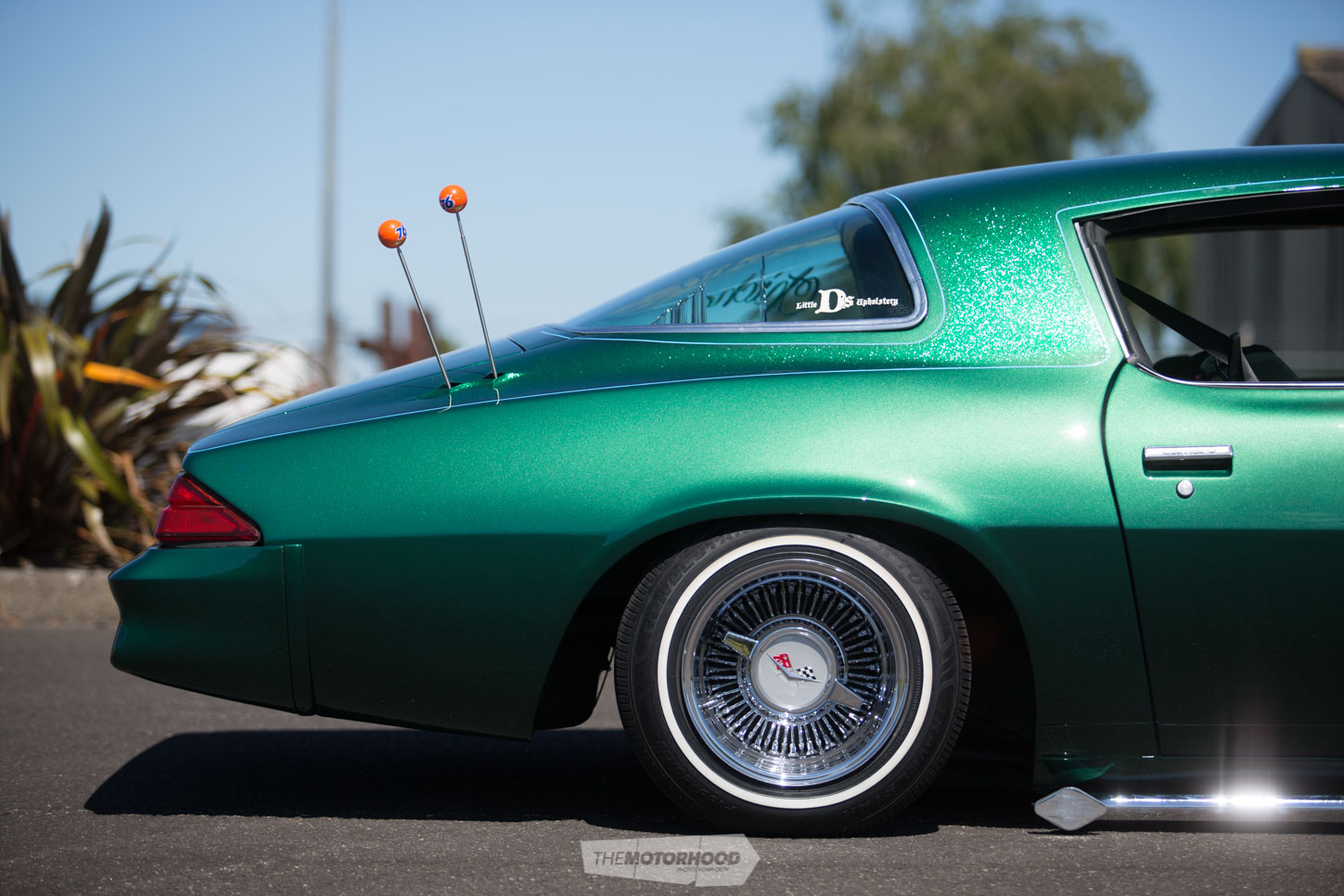
Kenny picked the car up on February 1, 2011 — a typical ’90s-style muscle car with fat tyres on the rear and a healthy dose of forward rake. Within two hours, he had it sitting on 13-inch wire wheels. He removed the rear spoiler and added a number of other low-riding touches. He was finally cruising, on his way towards that low-rider dream and knew that people would either love or hate his car.
“That didn’t bother me,” he explains. “I was building it for myself. It’s funny listening to some of the comments and seeing the faces of people looking at it.”
The next 18 months saw a variety of little aesthetic changes made to the Camaro, and it became the car that Kenny could let his friends cruise in without worrying about it — “It kept club brothers rolling while their cars were being built.”

Despite the number of little changes he was making to the car, including suspension tweaks, Kenny knew that what he really wanted was hydraulic suspension
Despite the number of little changes he was making to the car, including suspension tweaks, Kenny knew that what he really wanted was hydraulic suspension. The Camaro had already thrown a major spanner in the works before one could even be spun, as it was leaf sprung from factory, but that wasn’t to deter Kenny from his goal. A good second-hand hydraulic kit was sourced, and, with the help of his brother and Murray Storey at Valley Custom, was painstakingly installed.
“The front end was easy, but the rear was a whole different story,” Kenny remembers. The original plan to get around the whole leaf-spring problem was to remove the leaves and install a ladder-bar configuration. However, that plan was tweaked and evolved into a four-bar set-up with Panhard rod. Since the Camaro’s chassis rails already contain a healthy rear kick-up, there was no need for any notching, which did make life easier. That said, the relative lack of real estate meant that the positioning of all the components had to be very well thought out.

With the diff out of the car, having four-bar mounts welded to it, work could commence on the underside. The original front leaf-spring mounts were retained for the lower bars, and new upper mounting points were fabricated inside the car — this required custom tunnels to be fabricated to allow for upper-arm travel. With the arms sorted, the boot floor was then cut out for a 6mm ‘bridge’ plate to be welded in place, to which the shocks and hydraulic rams are now mounted.
“I can’t remember how many times I removed and reinstalled the diff to get things perfect,” Kenny says, “but seeing the car laid out for the first time reminded me why we were doing all this work. In my eyes, it was perfect — the body design looks so right hugging the ground.”
The suspension side of things was finished off with a pair of CCE hydraulic pumps installed in the boot quarters — one for the front suspension, one for the rear — a pair of batteries mounted on the bridge plate, and the installation of the hydraulic lines. In car, the system is controlled with a six-switch set-up, with two switches controlling the front and rear, and the remaining four in charge of each corner.

At least the LVVTA certification process was less of a headache than the work that preceded it, and Kenny’s Camaro was signed off and 100-per-cent road legal in time for the summer of 2013.
Now, Kenny could focus on the aesthetic side of things — after all, this is a low-rider and it’s got to do more than sit low and go up and down; it’s got to look the part while doing so, both inside and out. Starting inside, and with the help of his brother-in-law Mike Harrison, Kenny cut the front bucket seats down to low backs. This was done to open up the small cabin and make it feel bigger inside. Next up was the rear seat, modified to fit around the upper-arm mounting points, before the Camaro was sent off to Donna ‘Little D’ in Whangamata to be trimmed in the most ’70s of 1970s upholstery — green square-buttoned velvet, with pleated velvet and purple dingle-ball fringes and a matching dash pad.
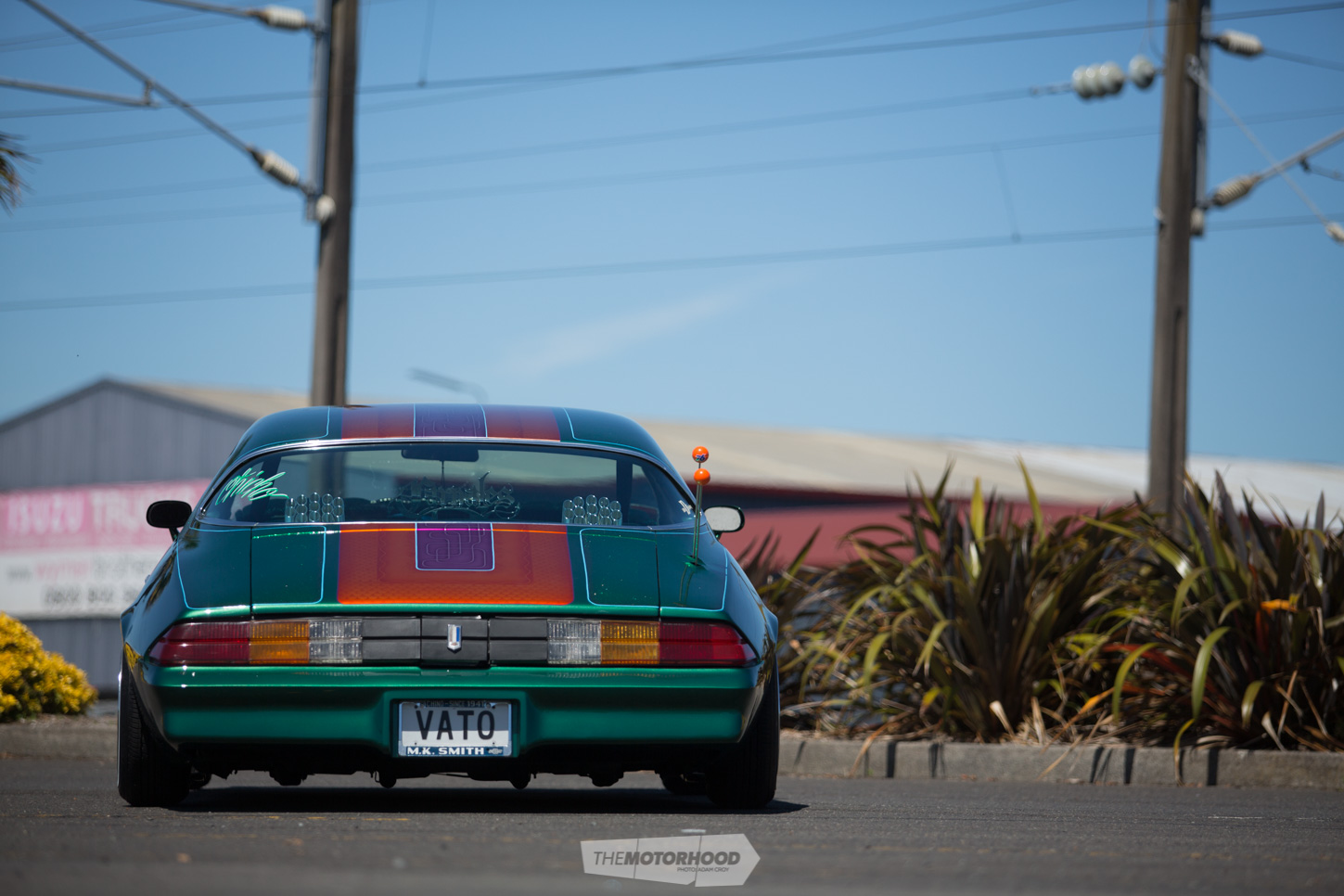
Outside, Kenny installed a pair of antennae in the right rear quarter, with frenched diamond-shaped recesses — perfect for that old-school theme! While he was at it, some rust in the doors was taken care of before it got too out of control. Then, the car was ready to go for the summer of 2014, primer patches and all.
“I cruised that summer with primer patches, and I liked it,” Kenny says. “It gave the car attitude; a hard, streetwise personality.”
Of course, you can see that the Camaro’s finish has come miles since then. The following winter saw the Camaro stripped down for Fergus Hope at Peninsula Panel and Paint in Whangamata to bless with his magic touch. A few body panels were eased back to shape, and the car was blasted with a metallic green. Then, working with Kenny towards a low-rider style finish, Ferg laid down the metal-flake green as well as a silver base for the candy effects Kenny was planning.

“It’s not about the destination but the journey. Whether it’s in terms of the build or the actual drive, what really matters is having a good time with great company.”
“I got the car back home, where I laid down the purple and tangerine candy patterns using old-school techniques that included lace, endless line, and fish scales,” Kenny tells us. “That was all done with a lot of patience, an air brush, and the help of my good friend Ross Bennett.
“When we finished the painting and peeled off all the masking, I couldn’t believe we’d pulled it off or how good it looked. Having never shot candies before, it all turned out amazingly well — it couldn’t have come out any better, in my opinion.”
Since then, the only addition has been the blue and purple pinstripes to outline the flaked and candied panels. The car has gone through a huge transformation, and Kenny’s certain that it’s not over yet.
“The build of the car was fun, but what I enjoyed most was the journey it took me on, the experiences, and the happiness it brings to me and anyone else who appreciates it.” Perhaps that’s the best way to describe the appeal of the low-riding culture, and Kenny’s Camaro in particular — it’s not about the destination but the journey. Whether it’s in terms of the build or the actual drive, what really matters is having a good time with great company.
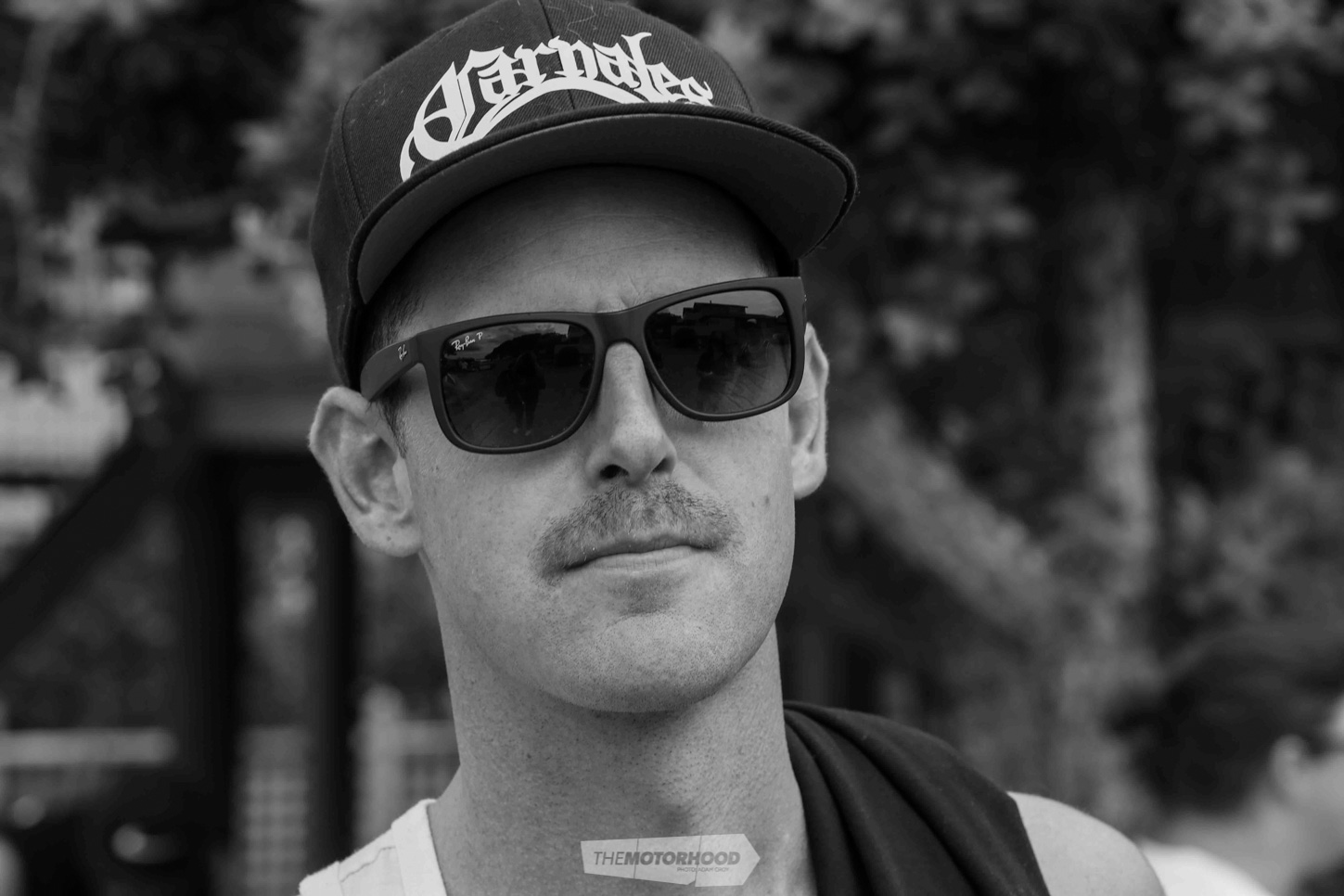
Kenny Harrison
Car club: Carnales New Zealand
Age: 33
Occupation: Graphic designer / Director
Previously owned cars: 1972 Corolla KE20s, 1982 Mitsubishi Lancer GSR Turbo, 1990 BMW E30, 1989 Honda Integra, 1985 Toyota Cressida, 1998 Toyota Mark. II, 1996 Ford Falcon wagon, 1938 Pontiac, 1953 Chev Bel Air; currently own a 1946 Chev Fleetmaster
Dream car: 1979 Lincoln Continental Diamond Jubilee Edition
Why the Camaro? I wanted another project and wanted it to be something a little different
Build time: Four-and-a-half years
Length of ownership: Four-and-a-half years
Kenny thanks: My girlfriend, Arihia; my brother, Chris, for all the help; my dad, Grant, for bringing me up around cars and for all the fine-tuning; Murray Storey at Valley Custom; my brother-in-law, Mike Harrison, for the interior modifications; Donna ‘Little D’ for the upholstery; Ferg Hope and the team at Peninsula Panel and Paint; Ross Bennett for the help with the candy pattern paint; Justin Ferris for being down since day one, inspiration, and someone to bounce ideas off; the entire Carnales club; and everyone else who motivated and inspired me through the build
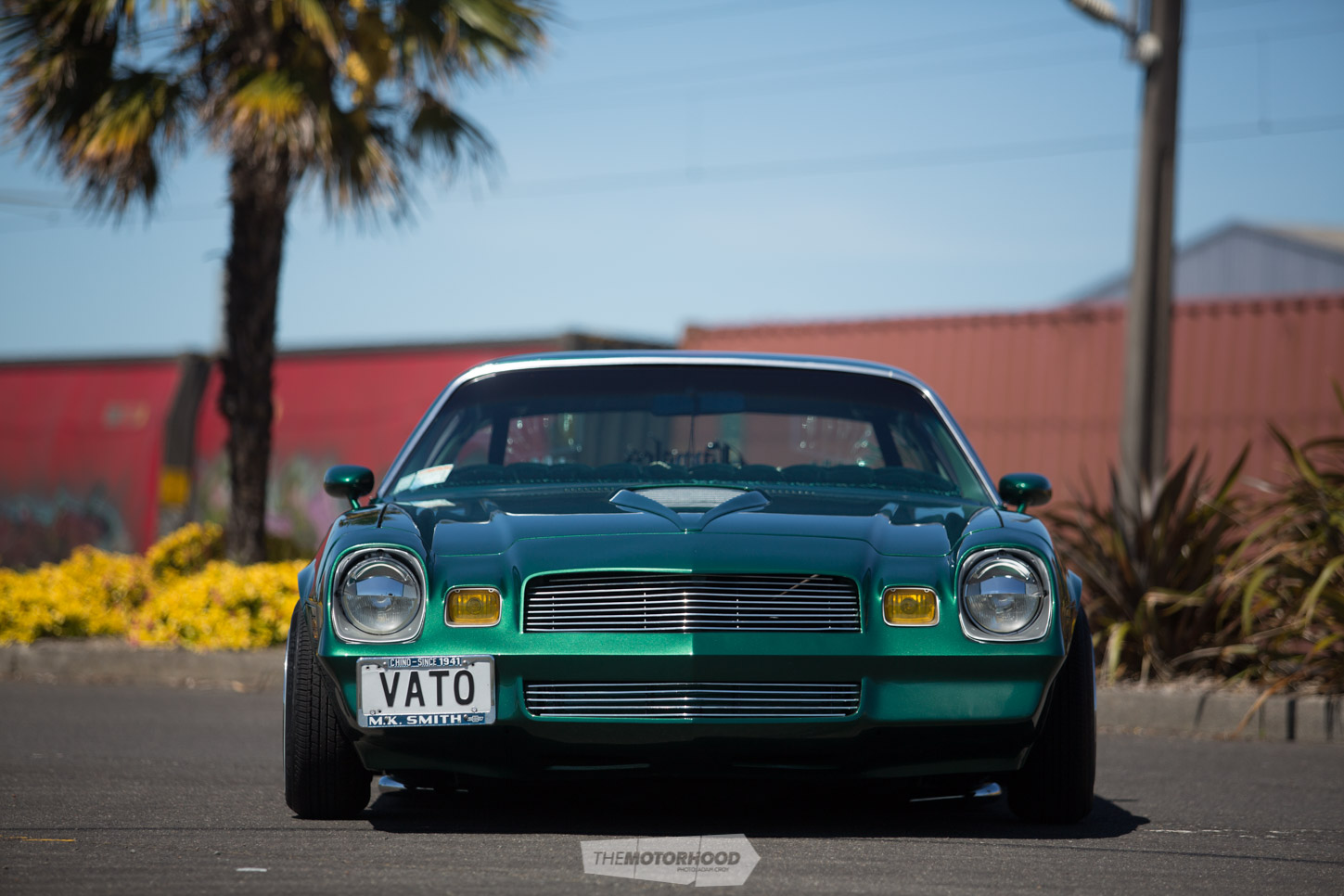
1978 Chev Camaro
Engine: 305ci small block Chev, Edelbrock intake manifold, Holley 600cfm carburettor, high-energy ignition, Hooker Shorty headers, straight-through exhaust, two-inch downpipes, stepped tailpipes from 1½ to 1¼ inch
Driveline: GM TH350 three-speed auto, shortened driveshaft, GM 10-bolt diff
Suspension: Relocated shock absorber mounts, four-bar rear conversion, Panhard rod, 24V hydraulic suspension, Hoppo’s six-inch front hydraulic rams, coil-under front suspension style, Hoppo’s 10-inch rear hydraulic rams, two CCE hydraulic pumps
Brakes: Factory front discs, factory rear drums
Wheels/Tyres: 13×7-inch Roadster 56-spoke bolt-on wire wheels, ’59–’60 Impala centre caps, 155/80R13 Travel Star whitewall tyres
Exterior: Camaro Z28 hood scoop, Camaro Z28 fender vents, twin diamond-shaped frenched antennae, custom grille, Lake pipes; metallic forest green base colour, green metal-flake panelling over roof and boot, House of Kolor Kandy Purple and Kandy Tangerine fish scale, lace, endless line techniques, purple and blue pinstriping
Chassis: Rear four-bar conversion, custom suspension arm mounts, 6mm suspension mounting plate
Interior: Metal-flake green nine-inch steering wheel, custom low-back front bucket seats, modified rear seats, green square-buttoned and ruffled velvet upholstery, pleated velvet fringing with purple dingle-balls
Audio: Alpine head unit, 5×7-inch Kicker speakers, eight-inch Kicker hideaway sub, Sony amp, organ-pipe speaker grilles
Performance: Untested
This article originally appeared in NZV8 issue No. 131. To get your hands on a print copy or digital copy, follow the links below:











